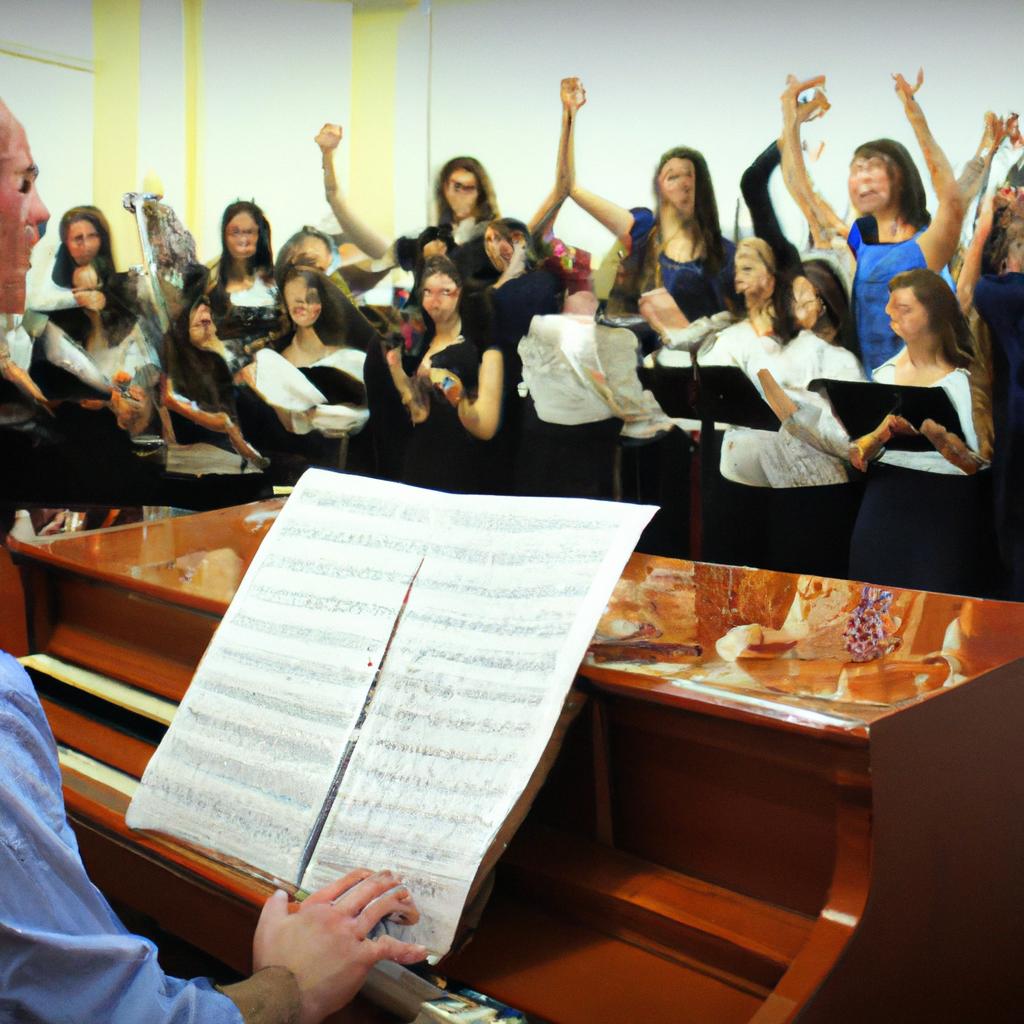Vocal expression plays a crucial role in the overall quality and impact of vocal ensembles. It is through the skillful manipulation of vocal techniques and harmonious blending of voices that these ensembles create their unique soundscapes. This article aims to explore the concept of harmony in vocal ensemble performance, focusing specifically on how it contributes to the overall vocal expression.
Consider an imaginary case study of a professional vocal ensemble preparing for a concert. As they delve into their repertoire, one can observe how the intricate interplay between individual voices creates a seamless tapestry of sound. The singers meticulously navigate through complex harmonies, ensuring each note resonates with precision and clarity. By carefully balancing their dynamics and intonation, they achieve a sense of unity as their voices merge together in perfect unison or richly layered chords.
This article will discuss various aspects related to harmony in vocal ensemble performances. Firstly, it will examine how understanding different types of harmonies – such as homophonic, polyphonic, or contrapuntal – can enhance the expressive qualities of a piece. Secondly, it will explore the technical skills required by each singer to effectively contribute to harmonic progressions and chordal structures within an ensemble context. Lastly, it will delve into the importance of Lastly, it will delve into the importance of expressive interpretation and communication in vocal ensemble performances. While technical proficiency is essential, it is the emotional connection between the singers and the music that truly brings a performance to life. Through nuanced phrasing, dynamic contrasts, and sensitive timing, vocal ensembles can convey a range of emotions and captivate their audience.
Furthermore, this article will highlight the significance of active listening and responsiveness within a vocal ensemble. Each singer must be attuned to the subtle changes in harmony and adapt their own voice accordingly. By doing so, they contribute to the overall cohesion and fluidity of the ensemble’s sound.
Additionally, the article will touch upon the role of individual voice parts within a vocal ensemble’s harmonic framework. From basses providing a solid foundation to sopranos adding shimmering high notes, each voice part has its unique contribution to make. Understanding how these parts interact and complement each other allows for effective harmonization and creates a balanced blend of voices.
Ultimately, this exploration of harmony in vocal ensemble performance aims to highlight its integral role in creating an engaging and emotionally resonant musical experience. By mastering technical skills, embracing expressive interpretation, fostering active listening, and understanding the interplay between voice parts, vocal ensembles can elevate their performances to new heights of artistic excellence.
The Importance of Vocal Expression
The Importance of Vocal Expression
Vocal expression plays a crucial role in vocal ensemble performances, enhancing the overall musical experience for both performers and audiences. By effectively conveying emotions, intentions, and artistic interpretations through their voices, singers can create a captivating and immersive atmosphere that resonates with listeners. This section explores why vocal expression is essential in vocal ensembles and its impact on the harmonious blending of voices.
To illustrate this point, consider a hypothetical scenario where a vocal ensemble performs a piece without any emotional connection to the lyrics or lack of variety in tonal colors. The absence of expressive elements may result in a monotonous performance that fails to engage the audience emotionally. However, when singers bring forth genuine emotion into their delivery, such as sadness, joy, or longing, they captivate listeners by evoking empathy and creating an authentic connection between performer and audience.
One key aspect of vocal expression lies in the ability to convey dynamic contrasts effectively. A well-expressed soft passage followed by a powerful crescendo can evoke strong emotions within the listener’s heart. Similarly, changes in tempo or rhythm can be used strategically to emphasize certain phrases or lyrics. To further highlight these aspects:
- Intensity: Vocalists can vary volume levels throughout a song to accentuate specific moments or create contrast.
- Timbre: Altering tone quality allows for different emotional expressions; warm tones for intimacy while bright tones for excitement.
- Articulation: Precise diction aids clarity of lyrical meaning and enhances emotional delivery.
- Phrasing: Skillful use of breath control enables seamless transitions between notes/phrases, adding depth to the performance.
In addition to employing these techniques successfully, it is important for vocal ensemble members to maintain harmony among their individual contributions. In order to achieve this synergy, performers must actively listen to one another while executing precise timing and pitch accuracy. Communication through eye contact and body language also aid in synchronizing vocal expressions, resulting in a cohesive and impactful performance.
By delving into the intricacies of vocal techniques, performers can further enhance their ability to express themselves effectively. In the subsequent section, we will explore various technical aspects that contribute to achieving vocal expression within a vocal ensemble setting. Through an understanding of these techniques, singers can refine their artistry and create compelling performances that leave a lasting impression on audiences.
Understanding Vocal Techniques
Building upon the understanding of vocal expression’s significance, we now delve deeper into the realm of vocal techniques and their role in enhancing harmony within a vocal ensemble.
Vocal Expression plays a pivotal role in creating harmonious interactions within a vocal ensemble. By incorporating various vocal techniques, singers can elevate their performances to new heights, captivating audiences with their artistry. For instance, consider a hypothetical case study where an acapella group is preparing for a competition. Through the implementation of specific techniques, they aim to enhance their collective sound and deliver an emotionally charged rendition of a classic ballad.
To achieve this objective, several fundamental vocal techniques come into play:
- Breath Control: A crucial element that enables sustained notes and controlled phrasing.
- Diction: The clarity and precision with which each word is enunciated contribute to effective communication with the audience.
- Articulation: Shaping consonant sounds precisely helps create crisp beginnings and endings of words.
- Vibrato: Controlled oscillations in pitch serve as embellishments adding depth and emotion to individual voices.
By harnessing these techniques effectively, singers can unlock the true potential of their voices and collectively produce harmonies that resonate deeply within the hearts of listeners.
Table – Emotional Response through Vocal Techniques:
| Technique | Emotion Elicited |
|---|---|
| Dynamic Range | Expressiveness |
| Tone Quality | Warmth |
| Blend | Unity |
| Phrasing | Musicality |
Through dynamic ranges that encompass soft whispers to powerful crescendos, performers effortlessly convey emotions ranging from vulnerability to strength. Additionally, carefully crafted tone quality evokes warmth that envelops listeners while establishing an intimate connection between performer and audience. Furthermore, seamless blend among voices fosters unity within the ensemble, allowing each singer’s contribution to complement one another. Finally, thoughtfully executed phrasing enhances musicality, adding depth and nuance to the ensemble’s interpretation of a piece.
In this section, we explored the significance of vocal techniques in enhancing harmony within a vocal ensemble. By employing breath control, diction, articulation, and vibrato effectively, singers can unleash their full potential and deliver emotionally compelling performances. Building upon this understanding of vocal expression, our subsequent exploration will delve into the world of dynamics within a vocal ensemble.
As we venture further into the realm of vocal performance, let us now turn our attention towards exploring dynamics in a vocal ensemble – an integral aspect that adds dimensionality and captivates audiences with its diverse range of expressive possibilities.
Exploring Dynamics in Vocal Ensemble
Building upon the foundation of understanding vocal techniques, let us now delve into the importance of vocal expression in a vocal ensemble. By exploring how harmony is achieved through various means, we can gain insight into the intricacies of this art form.
Harmony plays a pivotal role in enhancing the overall impact and emotional resonance of a vocal ensemble performance. Consider, for example, a hypothetical case study where an all-female choir aims to convey feelings of hope and empowerment through their rendition of a powerful anthem. The singers must employ specific vocal expressions to achieve harmonic unity and amplify their message effectively.
To accomplish this goal, there are several key aspects that contribute to creating harmonious vocals within an ensemble:
-
Blend: Achieving blend involves each singer matching not only pitch but also tone quality with those around them. It requires careful attention to dynamics, vowel formation, and breath control so that individual voices seamlessly merge together as one cohesive unit.
-
Balance: Striking the right balance between the different voice parts is crucial for achieving harmonic clarity. Each section – soprano, alto, tenor, bass – should be heard distinctly while still contributing harmoniously to the overall sound. This delicate equilibrium ensures no single part dominates or gets overshadowed by others.
-
Intonation: Accurate intonation is fundamental in creating harmonies that are pleasing to the ear. Singers must pay close attention to tuning intervals correctly and maintaining pitch accuracy throughout a piece. Any slight deviation can disrupt the desired consonance among voices and compromise the intended emotional impact.
-
Musical phrasing: Effective musical phrasing adds depth and nuance to vocal performances by highlighting significant melodic lines or lyrics within a composition. Cohesion in phrasing across multiple voices fosters seamless transitions between sections and enhances expressive delivery.
| Aspect | Description |
|---|---|
| Blend | Matching pitch, tone quality, dynamics, vowel formation, and breath control |
| Balance | Striking equilibrium between voice parts for harmonic clarity |
| Intonation | Accurate pitch tuning to maintain consonance among voices |
| Phrasing | Cohesion in highlighting melodic lines or lyrics within a composition |
By incorporating these elements of vocal expression into their performance, the hypothetical all-female choir can achieve harmonies that effectively convey feelings of hope and empowerment. Through careful attention to blend, balance, intonation, and musical phrasing, they create an immersive experience for both themselves and the audience.
As we explore how vocal expression contributes to the richness of ensemble performances through harmony, it is crucial to understand another vital aspect – mastering articulation and phrasing. By refining these skills further, performers can elevate their ability to communicate with precision and emotion.
Mastering Articulation and Phrasing
Building upon the exploration of dynamics in vocal ensemble, we now delve into another crucial aspect of vocal expression – harmony. By understanding how harmonies work within a vocal ensemble, singers can enhance their ability to create a cohesive and captivating musical experience.
Articulation and phrasing play pivotal roles in conveying the intended emotional message of a vocal performance. Let us consider an example where two singers are performing a duet with rich harmonies. As they sing together, precise articulation ensures that each note is crisply enunciated, allowing the intricate harmonic relationship to shine through. Furthermore, skillful phrasing guides the singers as they navigate through melodic lines, emphasizing key moments and creating expressive contours that evoke specific emotions.
To fully grasp the significance of harmony in vocal expression, let’s explore some essential techniques:
- Blend: Achieving a seamless blend among voices is crucial for harmonious singing. Singers must match timbre, vowel shapes, and intensity levels to create a unified sound.
- Balance: Balancing individual voice parts within the ensemble ensures that no one voice dominates or gets lost amidst others. This allows for clarity and enhances the overall impact of harmonies.
- Intonation: Precise intonation contributes greatly to the beauty of harmonies by ensuring accurate pitch relationships between voices.
- Chord Structure: Understanding chord progressions and voicing choices enables singers to interpret harmonies effectively.
Consider this three-column table highlighting various elements contributing to effective harmony:
| Element | Importance | Impact |
|---|---|---|
| Blend | Essential | Creates unity |
| Balance | Crucial | Enhances clarity |
| Intonation | Imperative | Ensures accuracy |
| Chord Structure | Fundamental | Facilitates interpretation of harmonies |
By mastering these techniques and understanding the significance of harmony within vocal ensembles, singers can elevate their performances to new heights. Mastery in articulation, phrasing, blend, balance, intonation, and chord structure empowers vocalists to harness the emotional potential inherent in harmony.
Transition into subsequent section about “Emotional Communication through Vocal Expression”:
Building upon our exploration of harmony in vocal ensemble performance, we now turn our attention to another vital aspect – emotional communication through vocal expression. By delving into how singers convey emotions effectively, we can unravel the true power of a well-executed performance.
Emotional Communication through Vocal Expression
Building upon the mastery of articulation and phrasing, the next crucial aspect to explore in vocal ensemble performance is vocal expression. By incorporating emotive techniques into their singing, vocalists can enhance the overall harmony and emotional impact of their collective sound. In this section, we will delve into the various elements that contribute to effective vocal expression within a vocal ensemble.
Vocal Expression in Vocal Ensemble: Harmony
Example Scenario:
Imagine a professional choir performing an intricate choral piece with multiple harmonies. As they reach a climactic moment in the composition, each vocalist subtly adjusts their dynamics and tone color to convey heightened intensity. This deliberate manipulation of expressive elements adds depth and emotion to the musical experience for both performers and listeners alike.
To fully grasp how vocal expression influences harmony in a vocal ensemble, consider the following key points:
- Emotional Engagement: Vocalists must connect emotionally with the lyrics and underlying message of a song. This connection enables them to express genuine emotions through subtle nuances in pitch, volume, timbre, and phrasing.
- Dynamic Variation: Altering dynamic levels throughout a piece allows singers to create contrast and shape within harmonies. The intentional use of crescendos or decrescendos helps highlight significant moments while maintaining balance across voices.
- Artistic Phrasing: Thoughtful interpretation of phrasing enhances harmonic coherence by ensuring seamless transitions between melodic lines. Singers may employ rubato (tempo flexibility) or slight delays at cadences to emphasize certain phrases or chords.
- Textual Emphasis: Paying attention to consonants, vowels, and word stresses aids in conveying lyrical meaning effectively as part of a unified whole.
The table below illustrates different aspects of vocal expression alongside corresponding effects on ensemble harmony:
| Aspect | Effect on Ensemble Harmony |
|---|---|
| Expressive Dynamics | Adds dimension |
| Nuanced Tone Color | Enhances emotional impact |
| Cohesive Phrasing | Strengthens melodic flow |
| Textual Clarity | Amplifies lyrical message |
In summary, vocal expression plays a pivotal role in creating harmonious and evocative performances within a vocal ensemble. By engaging emotionally with the material, utilizing dynamic variation, shaping phrasing, and emphasizing textual clarity, singers can elevate their collective sound to captivate audiences.
As we explore further techniques for enhancing vocal ensemble performance, let us now delve into the concept of improving vocal blend—an essential aspect that contributes to cohesive group singing without sacrificing individuality or expression.
Improving Vocal Blend in Ensemble Singing
Section H2 Transition: Building on the foundation of emotional communication through vocal expression, this section explores the significance of vocal blend in enhancing harmony within a vocal ensemble. By achieving a seamless integration of voices, ensembles can create a captivating and emotionally evocative performance that resonates deeply with their audience.
Section H2: Improving Vocal Blend in Ensemble Singing
To understand the importance of vocal blend in ensemble singing, consider the following scenario: imagine a choir performing a beautiful choral piece. As they begin to sing, each singer’s voice is distinct and separate from one another. The lack of unity creates an unsettling dissonance that fails to convey the intended emotion behind the composition. However, when those same voices seamlessly blend together, synchronizing pitches, tone quality, and dynamics, the result is transformative. The music becomes alive with rich harmonies capable of stirring profound emotions within both performers and listeners alike.
Enhancing Vocal Blend:
Achieving vocal blend requires dedicated effort from all members of an ensemble. Here are some key factors instrumental in improving vocal blend:
- Pitch Accuracy: Ensuring accurate pitch alignment among singers fosters harmonic cohesion essential for creating a unified sound.
- Tone Quality Consistency: Each vocalist must strive for consistent tonal production throughout their range, matching resonance characteristics as closely as possible.
- Dynamic Balance: Mastering control over individual volume levels allows singers to adjust their intensity collectively, resulting in balanced dynamics across the ensemble.
- Listening Skills: Active listening plays a vital role in developing awareness and responsiveness to fellow singers’ sounds during rehearsals and performances.
Table – Emotional Impact Through Vocal Blend (Hypothetical Example):
| Emotional Aspect | Vocal Technique | Effect |
|---|---|---|
| Intimacy | Softly blended voices | Creates an intimate atmosphere |
| Power | Unified crescendo | Builds anticipation and intensity |
| Serenity | Gentle sustained notes | Evokes a sense of tranquility |
| Joy | Bright, synchronized | Elicits feelings of happiness and elation |
By prioritizing vocal blend, ensemble singers can effectively convey the emotional nuances present within a composition. The harmonious fusion of voices creates an immersive experience that transcends individual performances, allowing the collective expression to resonate deeply with both performers and listeners. Through continuous practice and attention to detail in pitch alignment, tone quality consistency, dynamic balance, and listening skills, ensembles can achieve a heightened level of harmony that captivates audiences and communicates emotions in their purest form.
 Richmond Mens Chorus
Richmond Mens Chorus



